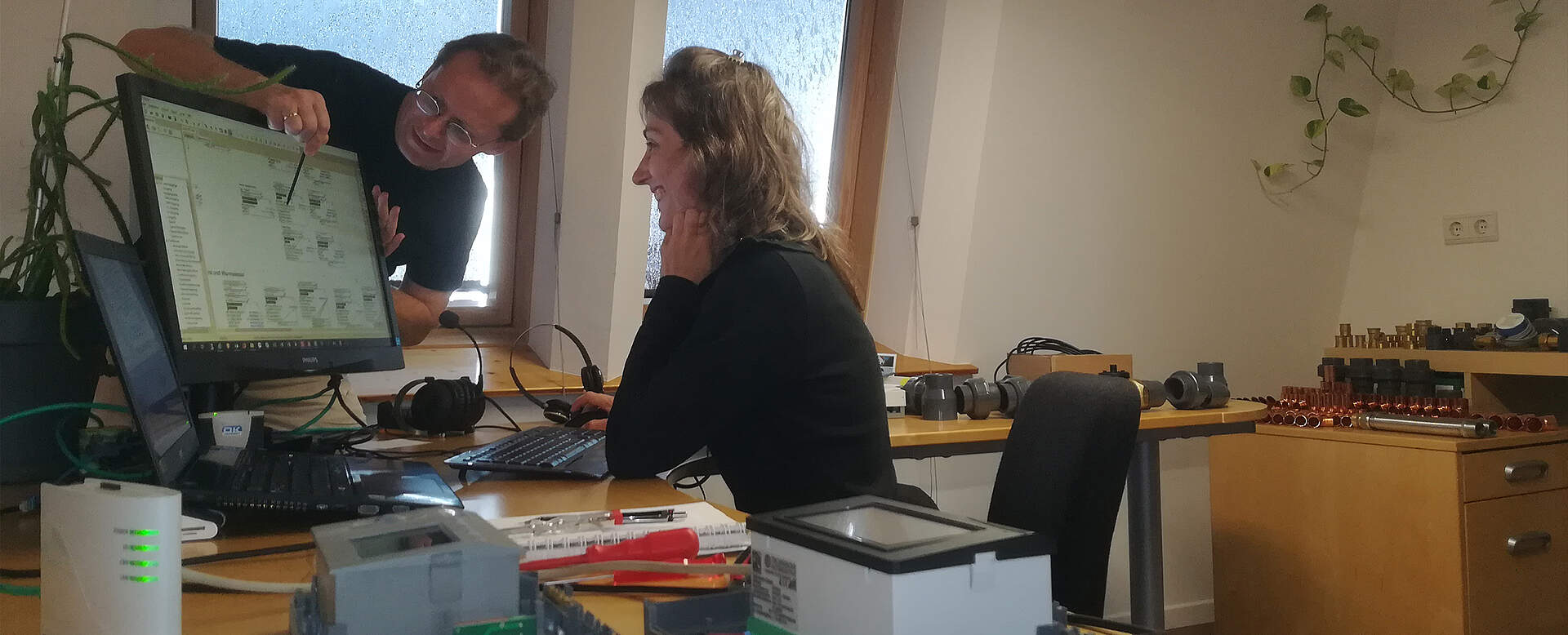Professional Tinkerers Interviewed

Their own system “LEO_2” is a service, rather than a product, since it’s customized to suit the circumstances and their customer’s wishes, as well being maintained solely “from afar”. The majority of their work consists of “forensic work”, looking for errors in systems already in place, changes to the construction of hydraulic systems and the regulation for an increase in efficiency, or support when switching heating systems.
You consider yourselves “physicists and professional tinkerers”. What do you mean by that?
“Tinkerer” implies our task to find out, in great detail, how something works and using that knowledge to find our own creative solution, using components already at hand, as far as possible – much like MacGyver. Many years ago, we worked as scientists, tinkering with experiments and programming regulators – nowadays, we support other tinkerers with their projects.
You support customers in the construction of individual heat pump systems. Could you elaborate that concept?
Our customers are technically ambitious DIY-kinds of people who construct their heat pump systems themselves, step by step. An already present heating system is implemented and an earth cellar (cistern, swimming pool, etc.) is reconstructed to a heat source. We supply detailed construction manuals for the heat exchanger in this tank and the tube collector (energy fence), and we accompany the project solely “from afar” – this includes taking things into service together as well as an online session. An important part of our service is the programming of regulation logistics, tailored to our customer’s system.
That sounds fairly complex. What’s the advantage of a system like that?
The fact that it’s no standardized system or product, but an individualized service. Our customers reach out to us because they are looking for a way to realize their own ideas for a heat source, especially because they want to be in charge of the details of their heating system, instead of some inaccessible “Blackbox” as a regulator.
So, it’s not always “your” concept with heating pumps, ice storage and energy fence. You generally support your customers in realizing their own ideas or simply with problems concerning heating. From a regulation point of view, as well as the basic concept (like hydraulics). Am I right there?
Exactly! The “regulation and hydraulic forensics” are the center of our attention at this point. A typical example: a solar/heating system doesn’t work as expected or the customer wants to expand the system. They meet their limits, however, when it comes to the system’s behavior, the possibilities of intervening in the system and with the producer’s support. We create a concept for the new regulator, incl. necessary changes in hydraulics, and program the UVR-controller. The most important part are the startup phase and the optimization phase, which we continuously monitor from afar.
You use the UVR16x2 for regulation and the C.M.I. for remote access and data logging. How did you stumble upon these devices (the predecessor was the UVE1611, after all) and why don’t you use something else?
Back then, we were looking for an affordable regulator for our pilot project, one that can manage all components in the heating circuit and the heat source according to our demands, one that can be freely programmed. Most “industrial” solutions seemed a bit overkill, but on the other hand we wanted a reliable software platform that’s being maintained, and not start programming from square one with some regulator.
The upgrade from the UVR1611 to x2-technology with the UVR16x2 and the RSM610 is something that many people find difficult, due to time limitations and often due to fear of new things. What motivated you to upgrade?
At first, the 16x2 seemed like some new “toy”. But as time went on, we discovered details, that proved useful for our heat pump systems as well as other regulation projects – be it the user defined designations, the many possibilities for logging or the new and improved functions. The “calendar”, for example, was the last missing piece for the fully automated switching between heating season and cooling season, and our liquid level sensor (the “bubbler” ;) ) would not have been possible without “Sample & Hold” or the “Curve function”. Some of our customer’s requirements – like the takeover of external set values from a KNX-Bus – simply couldn’t be realized using the UVR1611.
Since you’ve mentioned KNX just now: The idea of a Smart Home is taking off rather slowly. What’s your take on the matter? When does a Smart Home make sense?
Depends on your view of that buzzword. We, for once, see it as very useful to have an overview the important “operating parameters” of one’s house, as well to log data to find errors. If some concept, however, seeks to put countless layers of software and cloud storage between me and a light switch or to greet me with lighting in my favorite color when entering a room… that leaves us rather skeptical ;-)
If you had one wish we’d grant you, what would it be? Some specific product, an extension module or a TAPPS2 function?
Mostly the continuous expansion of the C.M.I. as a “logging and management platform”, for example the automatic time synchronization of all CAN-Bus devices, viewing and starting firmware updates of those same devices, in addition to the C.M.I. itself. Perhaps also the logging of any amount of Modbus-inputs on the C.M.I. – directly into the logfile, as well as more command line options in Winsol.
That’s a lot of work, that much be said at this point. Thank you for the interesting interview!
You’re also specialized in the use of x2-tech with the UVR16x2 and the RSM610 and also have an interest in being presented on our website? Then simply contact us.